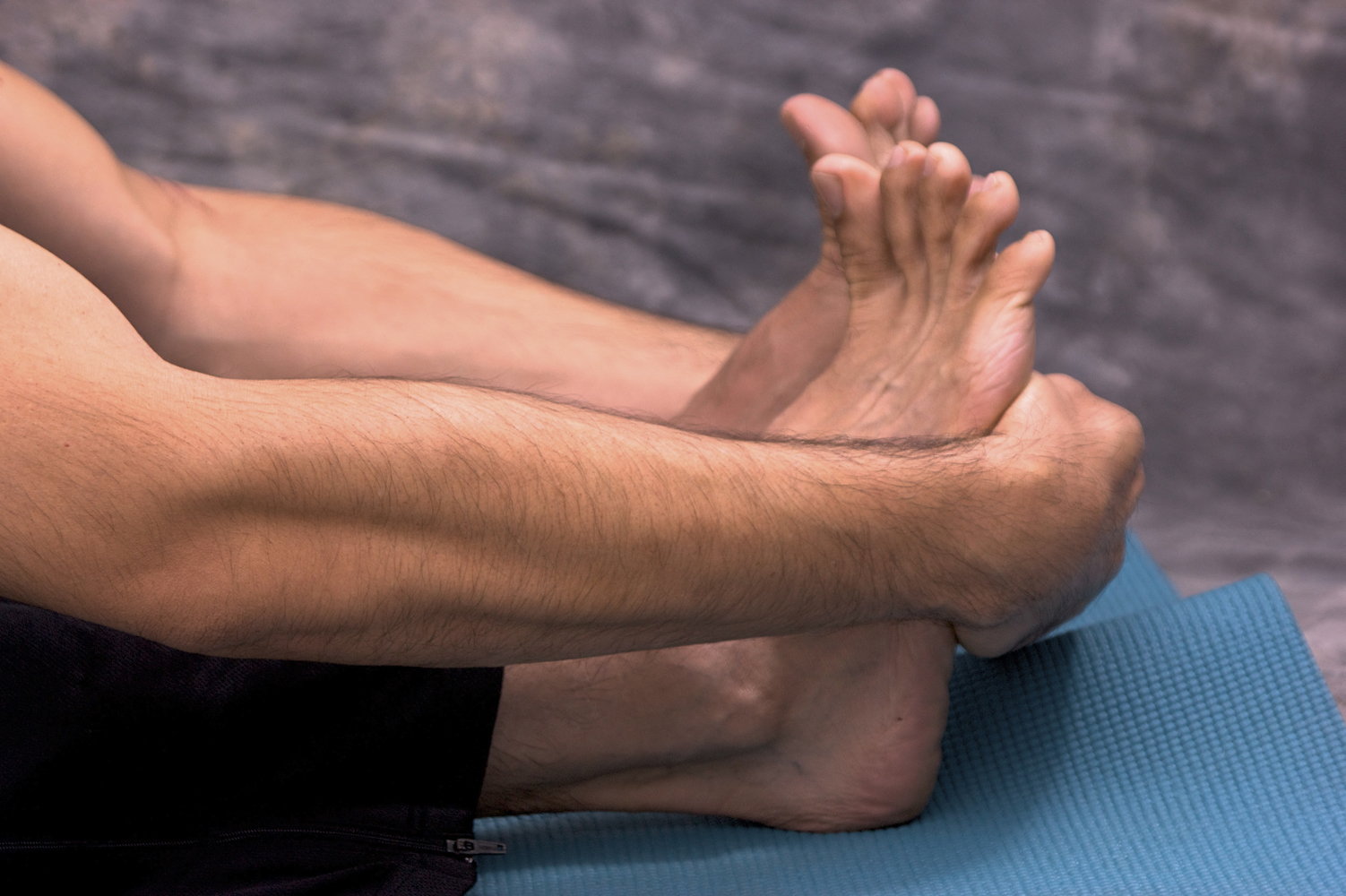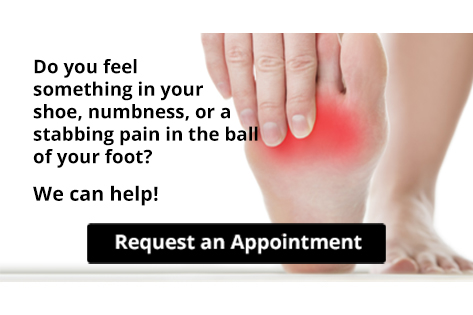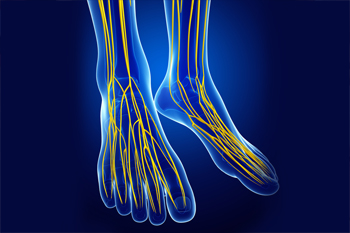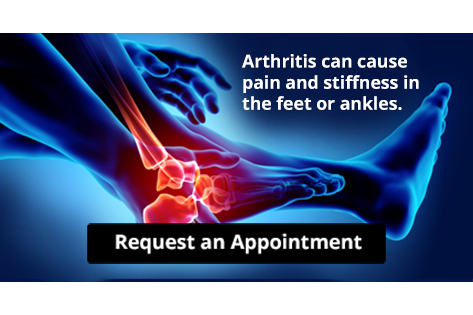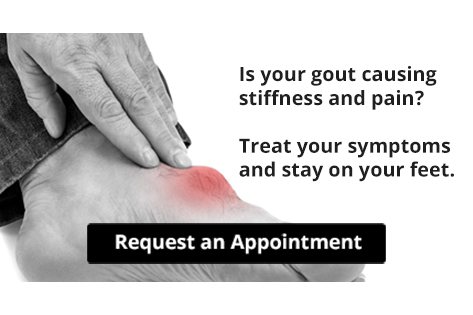Blog
Symptoms Associated With Ankle Pain
 Ankle pain can be the result of an injury or inflammation to any of the bones, joints, ligaments, muscles, or tendons found in the ankle. It is often accompanied by swelling, bruising, redness, numbness, tingling, stiffness, weakness, ankle instability, and difficulty bearing weight on the affected ankle. The symptoms that you might experience in addition to ankle pain will vary depending on the underlying cause. Those who have sprained or broken their ankles might notice swelling and bruising. Those who may have arthritis will likely experience joint stiffness and inflammation. If you have pain or any other unusual symptoms in your ankle, it is suggested that you consult with a podiatrist, who can diagnose and treat your condition.
Ankle pain can be the result of an injury or inflammation to any of the bones, joints, ligaments, muscles, or tendons found in the ankle. It is often accompanied by swelling, bruising, redness, numbness, tingling, stiffness, weakness, ankle instability, and difficulty bearing weight on the affected ankle. The symptoms that you might experience in addition to ankle pain will vary depending on the underlying cause. Those who have sprained or broken their ankles might notice swelling and bruising. Those who may have arthritis will likely experience joint stiffness and inflammation. If you have pain or any other unusual symptoms in your ankle, it is suggested that you consult with a podiatrist, who can diagnose and treat your condition.
Ankle pain can be caused by a number of problems and may be potentially serious. If you have ankle pain, consult with Shaun J. Limon, DPM and Lisa Griffith-Limon, DPM from Limons Foot & Ankle Care. Our doctors will assess your condition and provide you with quality foot and ankle treatment.
Ankle pain is any condition that causes pain in the ankle. Due to the fact that the ankle consists of tendons, muscles, bones, and ligaments, ankle pain can come from a number of different conditions.
Causes
The most common causes of ankle pain include:
- Types of arthritis (rheumatoid, osteoarthritis, and gout)
- Ankle sprains
- Broken ankles
- Achilles tendinitis
- Achilles tendon rupture
- Stress fractures
- Bursitis
- Tarsal tunnel syndrome
- Plantar fasciitis
Symptoms
Symptoms of ankle injury vary based upon the condition. Pain may include general pain and discomfort, swelling, aching, redness, bruising, burning or stabbing sensations, and/or loss of sensation.
Diagnosis
Due to the wide variety of potential causes of ankle pain, podiatrists will utilize a number of different methods to properly diagnose ankle pain. This can include asking for personal and family medical histories and of any recent injuries. Further diagnosis may include sensation tests, a physical examination, and potentially x-rays or other imaging tests.
Treatment
Just as the range of causes varies widely, so do treatments. Some more common treatments are rest, ice packs, keeping pressure off the foot, orthotics and braces, medication for inflammation and pain, and surgery.
If you have any questions, please feel free to contact our office located in Lakewood Ranch, FL . We offer the newest diagnostic and treatment technologies for all your foot care needs.
What Is Cryotherapy for Foot Warts?
 Warts that pop up on the bottom of the feet are known as plantar warts. One of many potential treatments for this condition is cryotherapy, in which the wart is frozen using liquid nitrogen. During this procedure, your doctor may first trim the wart. Sometimes, a local anesthetic may be injected into the area to reduce pain. Then, the doctor applies liquid nitrogen to the wart using a probe, cotton swab, or by spraying it directly onto the wart. Most warts require one to four cryotherapy treatments, with up to three weeks between treatments, to get full results. The area usually heals within one to two weeks with minimal or no scarring. If you suffer from plantar warts, it is suggested that you see a podiatrist to discuss treatment options.
Warts that pop up on the bottom of the feet are known as plantar warts. One of many potential treatments for this condition is cryotherapy, in which the wart is frozen using liquid nitrogen. During this procedure, your doctor may first trim the wart. Sometimes, a local anesthetic may be injected into the area to reduce pain. Then, the doctor applies liquid nitrogen to the wart using a probe, cotton swab, or by spraying it directly onto the wart. Most warts require one to four cryotherapy treatments, with up to three weeks between treatments, to get full results. The area usually heals within one to two weeks with minimal or no scarring. If you suffer from plantar warts, it is suggested that you see a podiatrist to discuss treatment options.
Plantar warts can be very uncomfortable. If you need your feet checked, contact Shaun J. Limon, DPM and Lisa Griffith-Limon, DPM from Limons Foot & Ankle Care. Our doctors will assist you with all of your foot and ankle needs.
About Plantar Warts
Plantar warts are the result of HPV, or human papillomavirus, getting into open wounds on the feet. They are mostly found on the heels or balls of the feet.
While plantar warts are generally harmless, those experiencing excessive pain or those suffering from diabetes or a compromised immune system require immediate medical care. Plantar warts are easily diagnosed, usually through scraping off a bit of rough skin or by getting a biopsy.
Symptoms
- Lesions on the bottom of your feet, usually rough and grainy
- Hard or thick callused spots
- Wart seeds, which are small clotted blood vessels that look like little black spots
- Pain, discomfort, or tenderness of your feet when walking or standing
Treatment
- Freezing
- Electric tool removal
- Laser Treatment
- Topical Creams (prescription only)
- Over-the-counter medications
To help prevent developing plantar warts, avoid walking barefoot over abrasive surfaces that can cause cuts or wounds for HPV to get into. Avoiding direct contact with other warts, as well as not picking or rubbing existing warts, can help prevent the further spread of plantar warts. However, if you think you have developed plantar warts, speak to your podiatrist. He or she can diagnose the warts on your feet and recommend the appropriate treatment options.
If you have any questions please feel free to contact our office located in Lakewood Ranch, FL . We offer the newest diagnostic and treatment technologies for all your foot and ankle needs.
Stretching the Feet Before and After Running
If you are a runner, stretching the feet helps strengthen them, improve their flexibility, and prevent foot injuries. There are several simple foot stretches that you can do prior to and after running. One exercise that can help stretch the plantar fascia ligament that runs along the bottom of your foot is the foot flex. You can do this stretch by sitting down in a chair with one foot placed on top of your knee. Use your hands to gently press your foot into a pointed position and hold for several seconds. Then gently pull your foot into a flexed position and hold for several seconds. Repeat 10 times on each foot. For more information about the benefits of stretching your feet, please speak with a podiatrist.
Stretching the feet is a great way to prevent injuries. If you have any concerns with your feet consult with Shaun J. Limon, DPM and Lisa Griffith-Limon, DPM from Limons Foot & Ankle Care. Our doctors will assess your condition and provide you with quality foot and ankle treatment.
Stretching the Feet
Stretching the muscles in the foot is an important part in any physical activity. Feet that are tight can lead to less flexibility and make you more prone to injury. One of the most common forms of foot pain, plantar fasciitis, can be stretched out to help ease the pain. Stretching can not only ease pain from plantar fasciitis but also prevent it as well. However, it is important to see a podiatrist first if stretching is right for you. Podiatrists can also recommend other ways to stretch your feet. Once you know whether stretching is right for you, here are some excellent stretches you can do.
- Using a foam roller or any cylindrical object (a water bottle or soda can will do), roll the object under your foot back and forth. You should also exert pressure on the object. Be sure to do this to both feet for a minute. Do this exercise three times each.
- Similar to the previous one, take a ball, such as a tennis ball, and roll it under your foot while seated and exert pressure on it.
- Grab a resistance band or towel and take a seat. If you are using a towel, fold it length wise. Next put either one between the ball of your foot and heel and pull with both hands on each side towards you. Hold this for 15 seconds and then switch feet. Do this three times for each foot.
- Finally hold your big toe while crossing one leg over the other. Pull the toe towards you and hold for 15 seconds. Once again do this three times per foot.
It is best to go easy when first stretching your foot and work your way up. If your foot starts hurting, stop exercising and ice and rest the foot. It is advised to then see a podiatrist for help.
If you have any questions, please feel free to contact our offices located in Bradenton and Lakewood Ranch, FL . We offer the newest diagnostic and treatment technologies for all your foot care needs.
Read more about Stretching Your FeetWhy Live with Pain and Numbness in Your Feet?
Can I Still Exercise if I Have Sprained My Ankle?
 Ankle sprains are a common injury that occurs when the ligaments in the ankle are overstretched or torn. Whether or not you can continue to engage in physical activity and exercise shortly after sustaining your injury will depend on the severity of your sprain. With a mild sprain, simple stretches and light activities like walking or swimming may be tolerable. With more severe sprains, walking or bearing weight on the affected ankle can be very difficult and might limit your workout options. Regardless of the severity of the sprain, it is suggested that you speak with your podiatrist to determine whether or not you should continue to exercise shortly after enduring an ankle sprain.
Ankle sprains are a common injury that occurs when the ligaments in the ankle are overstretched or torn. Whether or not you can continue to engage in physical activity and exercise shortly after sustaining your injury will depend on the severity of your sprain. With a mild sprain, simple stretches and light activities like walking or swimming may be tolerable. With more severe sprains, walking or bearing weight on the affected ankle can be very difficult and might limit your workout options. Regardless of the severity of the sprain, it is suggested that you speak with your podiatrist to determine whether or not you should continue to exercise shortly after enduring an ankle sprain.
Although ankle sprains are common, they aren’t always minor injuries. If you need your ankle injury looked at, contact Shaun J. Limon, DPM and Lisa Griffith-Limon, DPM from Limons Foot & Ankle Care. Our doctors can provide the care you need to keep you pain-free and on your feet.
How Does an Ankle Sprain Occur?
Ankle sprains are the result of a tear in the ligaments within the ankle. These injuries may happen when you make a rapid shifting movement while your foot is planted. A less common way to sprain your ankle is when your ankle rolls inward while your foot turns outward.
What Are the Symptoms?
- Pain at the sight of the tear
- Bruising/Swelling
- Ankle area is tender to touch
- In severe cases, may hear/feel something tear
- Skin discoloration
Preventing a Sprain
- Wearing appropriate shoes for the occasion
- Stretching before exercises and sports
- Knowing your limits
Treatment of a Sprain
In many cases, the RICE method (Rest, Ice, Compression, and Elevate) is used to treat ankle sprains. However, you should see a podiatrist to see which treatment option would work best with your injury. In severe cases, surgery may be required.
It is important to ask your doctor about rehab options after you receive treatment for your injury. Stretching, strength training, and balance exercises may help the ankle heal while also preventing further injury.
If you have any questions, please feel free to contact our office located in Lakewood Ranch, FL . We offer the newest diagnostic and treatment technologies for all your foot care needs.
Why Do My Feet Feel Like They're Burning?
A burning sensation in the feet can affect any part of the foot and is typically caused by nerve damage. Various conditions can lead to nerve damage in the feet. One of the most common culprits is diabetes. About half of all people with diabetes develop peripheral neuropathy, which affects the nerves of the feet and can produce a burning sensation. Other medical problems that may damage the nerves that supply the feet, and therefore lead to a burning sensation, include small fiber sensory neuropathy, Charcot-Marie-Tooth disease, complex regional pain syndrome, excessive alcohol use, and tarsal tunnel syndrome. Conditions that are not related to nerve damage can also produce a burning sensation in the feet. These include athlete’s foot, erythromelalgia, and hypothyroidism, among others. If you have burning feet, please seek the care of a podiatrist.
Neuropathy
Neuropathy can be a potentially serious condition, especially if it is left undiagnosed. If you have any concerns that you may be experiencing nerve loss in your feet, consult with Shaun J. Limon, DPM and Lisa Griffith-Limon, DPM from Limons Foot & Ankle Care. Our doctors will assess your condition and provide you with quality foot and ankle treatment for neuropathy.
What Is Neuropathy?
Neuropathy is a condition that leads to damage to the nerves in the body. Peripheral neuropathy, or neuropathy that affects your peripheral nervous system, usually occurs in the feet. Neuropathy can be triggered by a number of different causes. Such causes include diabetes, infections, cancers, disorders, and toxic substances.
Symptoms of Neuropathy Include:
- Numbness
- Sensation loss
- Prickling and tingling sensations
- Throbbing, freezing, burning pains
- Muscle weakness
Those with diabetes are at serious risk due to being unable to feel an ulcer on their feet. Diabetics usually also suffer from poor blood circulation. This can lead to the wound not healing, infections occurring, and the limb may have to be amputated.
Treatment
To treat neuropathy in the foot, podiatrists will first diagnose the cause of the neuropathy. Figuring out the underlying cause of the neuropathy will allow the podiatrist to prescribe the best treatment, whether it be caused by diabetes, toxic substance exposure, infection, etc. If the nerve has not died, then it’s possible that sensation may be able to return to the foot.
Pain medication may be issued for pain. Electrical nerve stimulation can be used to stimulate nerves. If the neuropathy is caused from pressure on the nerves, then surgery may be necessary.
If you have any questions, please feel free to contact our office located in Lakewood Ranch, FL . We offer the newest diagnostic and treatment technologies for all your foot care needs.
Plantar Warts Can Be Treated!
When To See a Podiatrist for Ingrown Toenails
 Ingrown toenails are a common foot condition in which the toenails grow into the surrounding skin, rather than over it. This often occurs on the big toes and can result in symptoms such as pain, tenderness, swelling, and redness around the affected toe. While ingrown toenails generally respond well to at home treatments, sometimes they can become infected or frequently recur. They can also be a cause for concern due to underlying health conditions, like diabetes or peripheral artery disease. In these cases, it is suggested that you seek the care of a podiatrist who can offer the right treatments for you. Depending on the severity of the ingrown toenail, the podiatrist may gently lift the nail, prescribe antibiotics to treat infections, or partially or completely remove the nail.
Ingrown toenails are a common foot condition in which the toenails grow into the surrounding skin, rather than over it. This often occurs on the big toes and can result in symptoms such as pain, tenderness, swelling, and redness around the affected toe. While ingrown toenails generally respond well to at home treatments, sometimes they can become infected or frequently recur. They can also be a cause for concern due to underlying health conditions, like diabetes or peripheral artery disease. In these cases, it is suggested that you seek the care of a podiatrist who can offer the right treatments for you. Depending on the severity of the ingrown toenail, the podiatrist may gently lift the nail, prescribe antibiotics to treat infections, or partially or completely remove the nail.
Ingrown toenails can become painful if they are not treated properly. For more information about ingrown toenails, contact Shaun J. Limon, DPM and Lisa Griffith-Limon, DPM of Limons Foot & Ankle Care. Our doctors can provide the care you need to keep you pain-free and on your feet.
Ingrown Toenails
Ingrown toenails occur when a toenail grows sideways into the bed of the nail, causing pain, swelling, and possibly infection.
Causes
- Bacterial infections
- Improper nail cutting such as cutting it too short or not straight across
- Trauma to the toe, such as stubbing, which causes the nail to grow back irregularly
- Ill-fitting shoes that bunch the toes too close together
- Genetic predisposition
Prevention
Because ingrown toenails are not something found outside of shoe-wearing cultures, going barefoot as often as possible will decrease the likeliness of developing ingrown toenails. Wearing proper fitting shoes and using proper cutting techniques will also help decrease your risk of developing ingrown toenails.
Treatment
Ingrown toenails are a very treatable foot condition. In minor cases, soaking the affected area in salt or antibacterial soaps will not only help with the ingrown nail itself, but also help prevent any infections from occurring. In more severe cases, surgery is an option. In either case, speaking to your podiatrist about this condition will help you get a better understanding of specific treatment options that are right for you.
If you have any questions please feel free to contact our offices located in Bradenton and Lakewood Ranch, FL . We offer the newest diagnostic and treatment technologies for all your foot and ankle needs.
Read more about Ingrown ToenailsDiabetes and Its Impact on the Feet
 Diabetes can lead to various health complications in many parts of the body, and the lower limbs are especially susceptible to damage. Diabetic peripheral neuropathy, in which the nerves that innervate the lower limbs become damaged, can lead to a loss of sensation in the feet and ankles. Peripheral artery disease, in which the blood vessels that supply the lower limbs are compromised and blood flow to the area is reduced, can lead to poor wound healing on the feet. Together, these two conditions greatly increase the risk of developing diabetic foot ulcers (DFUs). DFUs can appear without being detected due to a lack of sensation and may heal slowly and poorly due to poor circulation. DFUs can also become infected, and lead to serious complications, including amputation. To learn how to care for diabetic feet, it is suggested that you consult with a podiatrist.
Diabetes can lead to various health complications in many parts of the body, and the lower limbs are especially susceptible to damage. Diabetic peripheral neuropathy, in which the nerves that innervate the lower limbs become damaged, can lead to a loss of sensation in the feet and ankles. Peripheral artery disease, in which the blood vessels that supply the lower limbs are compromised and blood flow to the area is reduced, can lead to poor wound healing on the feet. Together, these two conditions greatly increase the risk of developing diabetic foot ulcers (DFUs). DFUs can appear without being detected due to a lack of sensation and may heal slowly and poorly due to poor circulation. DFUs can also become infected, and lead to serious complications, including amputation. To learn how to care for diabetic feet, it is suggested that you consult with a podiatrist.
Diabetic foot care is important in preventing foot ailments such as ulcers. If you are suffering from diabetes or have any other concerns about your feet, contact Shaun J. Limon, DPM and Lisa Griffith-Limon, DPM from Limons Foot & Ankle Care. Our doctors can provide the care you need to keep you pain-free and on your feet.
Diabetic Foot Care
Diabetes affects millions of people every year. The condition can damage blood vessels in many parts of the body, especially the feet. Because of this, taking care of your feet is essential if you have diabetes, and having a podiatrist help monitor your foot health is highly recommended.
The Importance of Caring for Your Feet
- Routinely inspect your feet for bruises or sores.
- Wear socks that fit your feet comfortably.
- Wear comfortable shoes that provide adequate support.
Patients with diabetes should have their doctor monitor their blood levels, as blood sugar levels play such a huge role in diabetic care. Monitoring these levels on a regular basis is highly advised.
It is always best to inform your healthcare professional of any concerns you may have regarding your feet, especially for diabetic patients. Early treatment and routine foot examinations are keys to maintaining proper health, especially because severe complications can arise if proper treatment is not applied.
If you have any questions please feel free to contact our office located in Lakewood Ranch, FL . We offer the newest diagnostic and treatment technologies for all your foot and ankle needs.
Arthritis Can Cause Pain in the Feet and Ankles
More...
Did I Break My Ankle?
 The ankle is a joint that connects leg bones (the tibia and fibula) with a foot bone (talus), providing up-and-down movement, stability, and shock absorption for the foot. Ankle fractures typically occur when either or both of these leg bones break. Fractures are characterized as either stable (if talus moves normally), or unstable (if talus moves abnormally). To the average person, it can be hard to tell whether they are experiencing an ankle fracture or an ankle sprain—which occurs when the ligaments on the ankle are damaged. Some telltale signs of a fracture can be: a cracking sound when the injury occurs, numbness or tingling, pain over the ankle bone, or even a misshapen ankle. While both ailments are painful, an ankle fracture is much more serious. Consult with a podiatrist who will be able to diagnose the injury properly and provide necessary treatment.
The ankle is a joint that connects leg bones (the tibia and fibula) with a foot bone (talus), providing up-and-down movement, stability, and shock absorption for the foot. Ankle fractures typically occur when either or both of these leg bones break. Fractures are characterized as either stable (if talus moves normally), or unstable (if talus moves abnormally). To the average person, it can be hard to tell whether they are experiencing an ankle fracture or an ankle sprain—which occurs when the ligaments on the ankle are damaged. Some telltale signs of a fracture can be: a cracking sound when the injury occurs, numbness or tingling, pain over the ankle bone, or even a misshapen ankle. While both ailments are painful, an ankle fracture is much more serious. Consult with a podiatrist who will be able to diagnose the injury properly and provide necessary treatment.
Broken ankles need immediate treatment. If you are seeking treatment, contact Shaun J. Limon, DPM and Lisa Griffith-Limon, DPM from Limons Foot & Ankle Care. Our doctors can provide the care you need to keep you pain-free and on your feet.
Broken Ankles
A broken ankle is experienced when a person fractures their tibia or fibula in the lower leg and ankle area. Both of these bones are attached at the bottom of the leg and combine to form what we know to be our ankle.
When a physician is referring to a break of the ankle, he or she is usually referring to a break in the area where the tibia and fibula are joined to create our ankle joint. Ankles are more prone to fractures because the ankle is an area that suffers a lot of pressure and stress. There are some obvious signs when a person experiences a fractured ankle, and the following symptoms may be present.
Symptoms of a Fractured Ankle
- Excessive pain when the area is touched or when any pressure is placed on the ankle
- Swelling around the area
- Bruising of the area
- Area appears to be deformed
If you suspect an ankle fracture, it is recommended to seek treatment as soon as possible. The sooner you have your podiatrist diagnose the fracture, the quicker you’ll be on the way towards recovery.
If you have any questions, please feel free to contact our offices located in Bradenton and Lakewood Ranch, FL . We offer the newest diagnostic and treatment technologies for all your foot care needs.
Read more about All About Broken AnkleDiabetic Foot Wounds May Heal Slowly
Diabetic foot wounds are chronic ulcers that may appear on the feet of people who have diabetes. Because these wounds heal slowly and poorly, and often become infected, diabetic foot ulcers are a major cause of lower limb amputations. Preventing these wounds from occurring in the first place continues to be an important goal for maintaining the overall health of people with diabetes. You can help prevent wounds by practicing good foot hygiene and wearing shoes and socks when you are on your feet. Performing daily foot inspections, in which you check your feet for any abnormalities—such as cuts, scrapes, sores, discoloration, and pain or strange sensations—can help detect problems early on and improve treatment outcomes. For more information about diabetic foot health, please consult with a podiatrist.
Wound care is an important part in dealing with diabetes. If you have diabetes and a foot wound or would like more information about wound care for diabetics, consult with Shaun J. Limon, DPM and Lisa Griffith-Limon, DPM from Limons Foot & Ankle Care. Our doctors will assess your condition and provide you with quality foot and ankle treatment.
What Is Wound Care?
Wound care is the practice of taking proper care of a wound. This can range from the smallest to the largest of wounds. While everyone can benefit from proper wound care, it is much more important for diabetics. Diabetics often suffer from poor blood circulation which causes wounds to heal much slower than they would in a non-diabetic.
What Is the Importance of Wound Care?
While it may not seem apparent with small ulcers on the foot, for diabetics, any size ulcer can become infected. Diabetics often also suffer from neuropathy, or nerve loss. This means they might not even feel when they have an ulcer on their foot. If the wound becomes severely infected, amputation may be necessary. Therefore, it is of the upmost importance to properly care for any and all foot wounds.
How to Care for Wounds
The best way to care for foot wounds is to prevent them. For diabetics, this means daily inspections of the feet for any signs of abnormalities or ulcers. It is also recommended to see a podiatrist several times a year for a foot inspection. If you do have an ulcer, run the wound under water to clear dirt from the wound; then apply antibiotic ointment to the wound and cover with a bandage. Bandages should be changed daily and keeping pressure off the wound is smart. It is advised to see a podiatrist, who can keep an eye on it.
If you have any questions, please feel free to contact our office located in Lakewood Ranch, FL . We offer the newest diagnostic and treatment technologies for all your foot care needs.
Gout Pain Can Be Managed
Is My Foot Sprained or Broken?
 Sometimes it can be difficult to tell the difference between a sprain and a foot fracture. Both injuries have very similar symptoms, including pain, swelling, and bruising. A fracture will often be so painful that you may not be able to walk. Sprains can also make walking difficult, depending on the severity of the injury. At the time that you injure your foot, you may hear a noise. A popping sound can indicate a sprain, while a cracking sound can indicate a fracture. Treatments for the two conditions are different, so it is important to get a proper diagnosis. If you have injured your foot, it is suggested that you see a podiatrist as soon as possible.
Sometimes it can be difficult to tell the difference between a sprain and a foot fracture. Both injuries have very similar symptoms, including pain, swelling, and bruising. A fracture will often be so painful that you may not be able to walk. Sprains can also make walking difficult, depending on the severity of the injury. At the time that you injure your foot, you may hear a noise. A popping sound can indicate a sprain, while a cracking sound can indicate a fracture. Treatments for the two conditions are different, so it is important to get a proper diagnosis. If you have injured your foot, it is suggested that you see a podiatrist as soon as possible.
A broken foot requires immediate medical attention and treatment. If you need your feet checked, contact Shaun J. Limon, DPM and Lisa Griffith-Limon, DPM from Limons Foot & Ankle Care. Our doctors can provide the care you need to keep you pain-free and on your feet.
Broken Foot Causes, Symptoms, and Treatment
A broken foot is caused by one of the bones in the foot typically breaking when bended, crushed, or stretched beyond its natural capabilities. Usually the location of the fracture indicates how the break occurred, whether it was through an object, fall, or any other type of injury.
Common Symptoms of Broken Feet:
- Bruising
- Pain
- Redness
- Swelling
- Blue in color
- Numbness
- Cold
- Misshapen
- Cuts
- Deformities
Those that suspect they have a broken foot shoot seek urgent medical attention where a medical professional could diagnose the severity.
Treatment for broken bones varies depending on the cause, severity and location. Some will require the use of splints, casts or crutches while others could even involve surgery to repair the broken bones. Personal care includes the use of ice and keeping the foot stabilized and elevated.
If you have any questions please feel free to contact our office located in Lakewood Ranch, FL . We offer the newest diagnostic and treatment technologies for all your foot and ankle needs.
